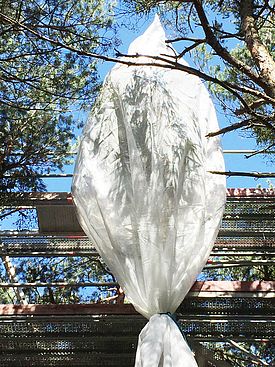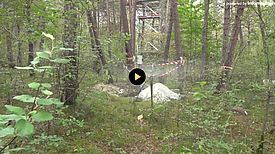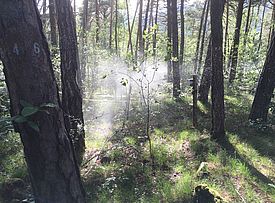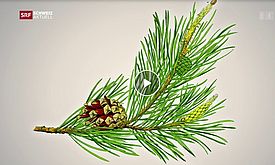
The Pfynwald research platform ¶
At the beginning of this century, numerous pines in the Rhone Valley, one of the driest inner alpine valleys of the European Alps, situated between Brig and Sion (Canton Valais), started showing symptoms of drought. Many older trees had already died. To investigate the causes of the pine dieback, the WSL launched a long-term irrigation experiment in the Pfyn-Finges Nature Park in summer 2003. Since then, the WSL has been comparing the responses of several hundred pines in irrigated forest plots with those of trees that continued to receive only the natural amount of precipitation.
Since 2024, we have implemented an additional, world-wide unique approach to disentangle the processes affected by atmospheric and soil droughts. For more details, see VPDrought-Experiment.
Contents ¶
Results from experiments in dry areas with a long series of in-situ measurements are necessary for a better understanding of the medium- to long-term effects of drought periods on forests.
As the largest contiguous pine forest in Switzerland, the Pfyn forest in Canton Valais (46° 18' N, 7° 36' E, 615 m asl) offers the best conditions for such measurements. In light of this, a WSL research team set up a long-term experiment that is to last 30 years in this forest. The average temperature here is 10.6°C (average 1995-2014), the yearly accumulated precipitation is 575 mm (average 1995-2014). The pines are about 130 years old and 12 m high. The test area comprises approx. 800 trees over a surface of 1.2 ha divided into 8 plots of 1000 m2 each (Figure 4). Between April and October, four of these plots are irrigated by a sprinkler system which provides an additional 600 mm of water annually. In the other four plots, the trees grow under natural, hence relatively dry conditions.
Results to date ¶

Almost immediately after measurements began in 2003, a considerable increase in the production of mycorrhiza fruit bodies was noticeable in the irrigated subplots. After a one-year lag, the pines have been forming wider tree rings and longer needles than before since 2004. In the following years, the length of the height and branch shoots and the stand density increased as well. From the summer 2006, irrigation has also increased root growth and led to more biomass, especially in the fine roots (Brunner et al. 2009). The growth period of irrigated trees was extended by 2 to 5 weeks (Eilmann et al. 2010).
Over the entire experimental period from 2003 to 2019, the irrigation experiment allowed us to track the recovery trajectories in trees and in the whole ecosystem released from the natural dry conditions. The monitoring data over 16 years showed that irrigation improved the soil water availability, and 120-year-old Scots pine trees were able to regain vigor by increasing shoot length, needle length and leaf area, and by decreasing crown transparency.
We detected rapid and stronger responses from above-ground tree traits compared to below-ground tree traits. The altered above-ground traits during the initial years of irrigation increased the water demand. Trees adjusted by increasing root biomass during the later years of irrigation, resulting in an increased survival rate of Scots pine trees in irrigated plots. However, after reaching the peak in 2006, the magnitude of the impact of irrigation on a number of tree-related variables declined in the following years. This declining trend after reaching the peak may indicate that the water supply at a constant rate over the years did not meet the progressively increasing water demand from increasing vegetation activities.
The results indicate that increased water availability in the long term changed tree and ecosystem properties in a way that a new balance between soil water availability and water demand is reached, which changed the boundary conditions of the ecosystem. The irrigation also stimulated foliar decomposition rate at ecosystem level, biomass of fungal fruit body, and abundance of regeneration in broadleaved tree species. However, irrigation did not promote the regeneration of Scots pine trees, which are reported to be vulnerable to extreme droughts (Bose et al. 2022).
In Switzerland, the temperature increase from the end of the 20th century to the beginning of the 21st was more than twice the global average. Climate models suggest that the 21st century will see a further rise in temperatures. In conjunction with the heat-related increase in evaporation and more frequent heat waves, it is safe to assume that the water supply available to trees is steadily deteriorating and that heavy rainfall is to be increasingly expected in the summer months. As this rainfall will increase surface water runoff and will not seep into the soil, plants will increasingly suffer from stress caused by drought. Consequently, the vitality and growth of the pines will drop. In the long term, drought may lead to an increasing number of tree deaths and cause vegetation areas to shift. This is particularly true for the forest ecosystem of inner-alpine dry valleys such as those in Valais (Rigling et al. 2013).
Links to the topic: Long-term Forest Ecosystem Research LWF, Sanasilva inventory
Sponsors ¶
We appreciate the long standing support received from HYDRO Exploitation SA in Sion and from the forest service Forstregion Leuk.
Project lead ¶
WSL publications ¶
Publications ¶
For an adequate citation of Pfyn forest studies and data, please include the following citation in the acknowledgements:
"The analysis was based on data from the long-term irrigation experiment Pfyn forest, which is part of Swiss Long-term Forest Ecosystem Research Program LWF (www.lwf.ch). We would like to extend special thanks to X, who put the Z data at our disposal."
Projects ¶
Multimedia ¶
More info at https://www.wsl.ch/drone-pfynwald-EN
In the media ¶
New study in the Pfyn Forest shows: Drought inhibits carbon storage by earthworms. ¶

Earthworms in drought sleep: Due to climate change, dry periods are getting longer and longer, which is putting a strain on soil organisms. A long-term study in the Pfynwald forest shows just how much. (Kanal 9, 9.06.2022).
Researchers: Dry forest soils can store less CO2 in the long term ¶
![[Translate to Englisch:] Trockene Waldböden können langfristig weniger CO2 speichern](/fileadmin/_processed_/7/7/csm_deutschlandfunk_CO2_d7b2da97be.jpg)
Dry forest soils have a negative effect on climate change because earthworms in particular can no longer contribute well to fixing carbon in the soils, explains material cycle expert Frank Hagedorn in Dlf. Earthworms decompose less leaf litter during drought. In the long term, less carbon and thus also climate-impacting CO2 would be stored in the soil.
Krauter, Ralf, Deutschlandfunk | 01. 06. 2022, 16:47
Mysterious network: How trees are connected in the forest ¶
Ecoacoustics: The soundtrack of climate change. SRF Einstein ¶
What does it sound like in the ground? What does the forest sound like in a dry summer? Eco-acousticians like the Swiss sound researcher Marcus Maeder describe nature in a completely new way with the help of sound recordings. Sound becomes an indicator of an ecosystem. "Einstein" shows what opportunities ecoacoustics opens up.
Pine dieback in Valais - researchers wrap the trees in plastic. ¶
Metadata and Maps ¶
Metadata
- Are you starting a new study or updating an ongoing one? Please download the excel-sheet with the metadata from Pfyn forest, complete it with your up-to-date information in red and send the file by mail to Marcus Schaub.
- Pfyn_Metadata_vrs49.xlsx
Map
- Pfynwald 2023 (1.7 MB)
Workshops ¶
Workshops
- 2024 Pfynwald Workshop, WSL, 7 March 2024
- 2022 Pfynwald Workshop, WSL, 14 Feb 2022
-
2020 Pfynwald Workshop, WSL, 17 Sept 2020
- 2014 Pfynwald Workshop
- 2013 Pfynwald Workshop
Terms of Use and Safety Concept ¶
Collaboration on the Pfynwald research platform is highly welcome! For your safety and for the integrity of the forest site, we kindly ask the collaborators to take note of the following Terms of Use and the Safety Concept.





